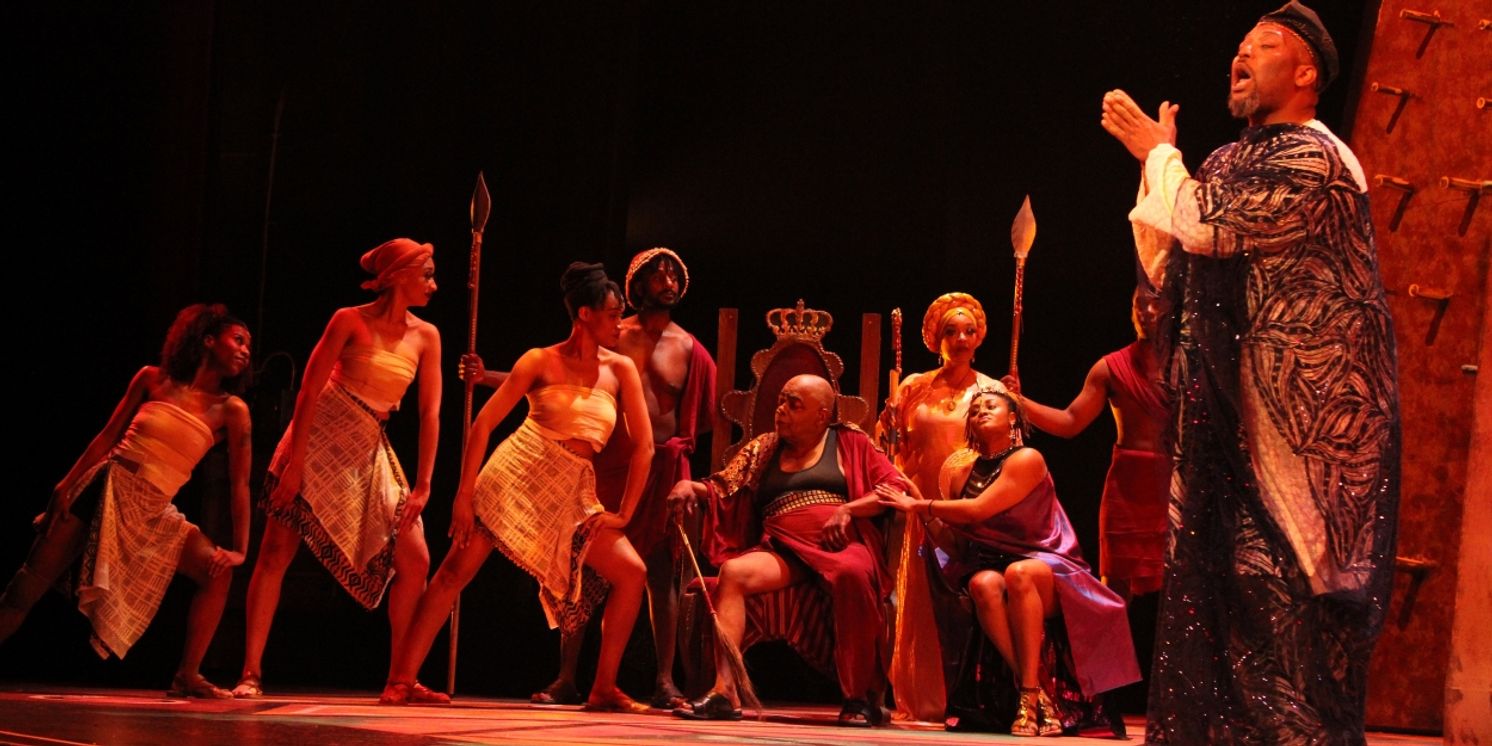Review: TIMBUKTU! at The Black Rep
Now at the Edison Theater, the production runs through June 9

It’s an old take on an old, old take on an old, old, old, old story. But it was new to me, and I’ll bet it’s new to most of you. It’s Timbuktu! at The Black Rep, directed by founder Ron Himes.
In 1911 an exotic/romantic/comic play opened in London. It was called Kismet (“fate”).
Medieval Baghdad! The Caliph seeks a bride, an itinerant poet seeks a meal, his daughter seeks love, the corrupt and wicked Wazir seeks further corruption—and his lubricious wife seeks outside entertainment.
The play was so popular that it was produced on Broadway, then made into four movies (1914, 1920, 1930, 1944).
In 1953 it became a hit musical—much of the music being based on the works of Alexander Borodin. We find luscious borrowings from his
- In the Steppes of Central Asia
- “Polovtsian Dances” (from the opera Prince Igor)
- Petite Suite
- String Quartet in D.
Borodin was among “The Five” Russian composers who sought to incorporate ethnic music into the classical repertoire, and the region he was musically describing was a vast Turkic Moslem expanse just across the Caucasus from Baghdad. So his music was not inappropriate to this tale.
Several of the songs in this show made the hit-parade:
- “Stranger in Paradise”
- “Night of My Nights”
- “And This Is My Beloved”
- “Baubles, Bangles, and Beads”
From the musical, of course, another movie was made.
This story has drawn the brightest stars of each era: Marlene Dietrich, Ronald Coleman, Alfred Drake, Richard Kiley, Howard Keel.
And in 1978 Timbuktu! was born. Now the show was transposed, almost intact, from Baghdad to Timbuktu—for an all-black cast.
Timbuktu, in western Africa on the edge of the Sahara, was for centuries the epitome of remoteness. In the 14th century it is said to have been the richest city in the world—its wealth deriving from trade in gold, salt, and slaves.
This new version of the musical also drew major talents: Geoffrey Holder, Eartha Kitt, Melba Moore.
The Black Rep produced the show in 1985, and now they’ve opened a brand new production. Of all the artists involved in the show three are so outstanding that they make this a memorable evening:
- Duane Foster, as the Poet. He fills this very demanding role with immense energy and spirit. His voice is rich and strong, his diction clarity itself, his timing and movement perfect, and his comic sense superb.
- Choreographer Haley Rhiney fills Timbuktu with wildly beautiful African dance. Time and again she joins Samantha Madison and Venezia Manuel to dazzle us with a frenzied, athletic flailing of limbs. Often the whole cast is dancing. It fills the hall with excitement.
- Master Drummer Caph Guei sits by the Down Left proscenium, nested in an array of African drums, large and small. He pours forth unbelievable joyous showers of complex rhythms. No human hands can drum so fast! Any human hands would be destroyed by such punishment. And he can send a sharp beat, loud like a gunshot near your head. Wow!! Mr. Guei, a native of Ivory Coast, is Music Director of Afriky Lolo.
The whole cast is strong. Drummond Crenshaw is a Black Rep veteran and favorite. {He’s been with the company at least 33 years.) He makes a comically cruel—and not too bright—Wazir.
Keith Tyrone Williams commands the stage as the dread river pirate. He’s a powerful, menacing presence.
Dereis Lambert as the Mansa (Caliph) and Evann De-Bose as Marsinah, the poet’s daughter, make a very sweet and handsome couple as the romantic focus of the plot.
Amarachi Kalu plays Sahleem-La-Luum, the Wazir’s insatiable wife. She makes a recipe for Turkish Delight seem absolutely salacious. This is a role originally played by Eartha Kitt, the world champion of such innuendo, but Ms. Kalu runs a close second. And she wears that glittery finery quite voluptuously.
The inimitable Kimmie Kidd does fine work as Najua, Sahleem’s confidante. Brian McKinley is strong and graceful as the Mansa’s friend and advisor.
Scenic designer Dunsi Dai presents a vivid world of reddish mud-brick buildings. Scenic artists Taylor Deed and Kenneth Randle give us a beautiful background of huge baobab trees, and a stage floor with vivid geometric patterns. Sean Savoie’s lighting is beautifully complex, with occasional wisps of fog catching the strong colors. Costumer Kristie Chiyere Osi dresses these ancient Malians with deep African style, yet with some glamour and glitz.
Kismet was a peculiar kind of show. Its structure is quite old fashioned, the plot a little complex, and its humor often approaches vaudeville. Musically it mixes the gentle, sweeping exoticism of Borodin with blatant Broadway numbers. Now, as Timbuktu!, it seems even more dated (with all those happy, sexy, subservient harem girls). And the African rhythms and dance, however splendid, make that awkward musical dichotomy a tri-chotomy.
The Black Rep has done some magnificent musicals, and Timbuktu isn’t the best of the lot—but it’s well worth an evening of your time. It continues at the Edison through June 9.
(Photo by Keshon Campbell)
Reader Reviews

Videos

